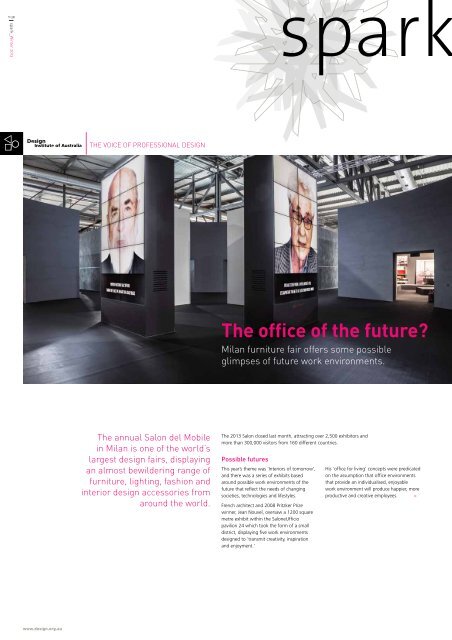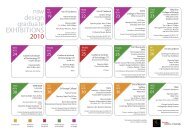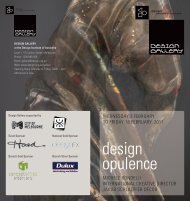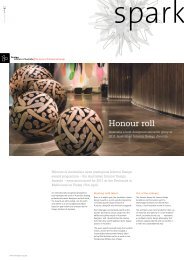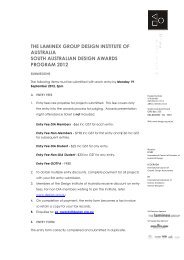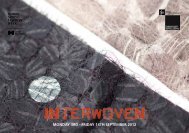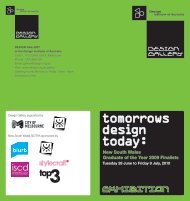Newsletter - Design Institute of Australia
Newsletter - Design Institute of Australia
Newsletter - Design Institute of Australia
Create successful ePaper yourself
Turn your PDF publications into a flip-book with our unique Google optimized e-Paper software.
No.28<br />
spark_Winter 2013<br />
The Voice <strong>of</strong> Pr<strong>of</strong>essional <strong>Design</strong><br />
The <strong>of</strong>fice <strong>of</strong> the future?<br />
Milan furniture fair <strong>of</strong>fers some possible<br />
glimpses <strong>of</strong> future work environments.<br />
The annual Salon del Mobile<br />
in Milan is one <strong>of</strong> the world’s<br />
largest design fairs, displaying<br />
an almost bewildering range <strong>of</strong><br />
furniture, lighting, fashion and<br />
interior design accessories from<br />
around the world.<br />
The 2013 Salon closed last month, attracting over 2,500 exhibitors and<br />
more than 300,000 visitors from 160 different countries.<br />
Possible futures<br />
This year’s theme was ‘Interiors <strong>of</strong> tomorrow’,<br />
and there was a series <strong>of</strong> exhibits based<br />
around possible work environments <strong>of</strong> the<br />
future that reflect the needs <strong>of</strong> changing<br />
societies, technologies and lifestyles.<br />
French architect and 2008 Pritzker Prize<br />
winner, Jean Nouvel, oversaw a 1200 square<br />
metre exhibit within the SaloneUfficio<br />
pavilion 24 which took the form <strong>of</strong> a small<br />
district, displaying five work environments<br />
designed to ‘transmit creativity, inspiration<br />
and enjoyment.’<br />
His ‘<strong>of</strong>fice for living’ concepts were predicated<br />
on the assumption that <strong>of</strong>fice environments<br />
that provide an individualised, enjoyable<br />
work environment will produce happier, more<br />
productive and creative employees. ><br />
www.design.org.au
Winter_2013<br />
:to kindle,<br />
excite or<br />
animate<br />
<strong>Design</strong>ers, by our very nature, are great collaborators. Typically we<br />
work with colleagues and consultants during the design phase <strong>of</strong><br />
a project and we depend on builders, printers, manufacturers and<br />
a host <strong>of</strong> other people to realise our visions. Importantly, we also<br />
collaborate with our clients, which is a key differentiator between<br />
the way that designers work and the way that craftspeople or<br />
artists typically work. Invariably, there are times when we wish we<br />
weren’t so dependent on others but there’s no avoiding it. The most<br />
successful designers are <strong>of</strong>ten the most successful collaborators too.<br />
01<br />
For the <strong>Design</strong> <strong>Institute</strong> <strong>of</strong> <strong>Australia</strong>, collaboration is also a necessity<br />
and this year, we are focusing a great deal <strong>of</strong> attention on it. For<br />
up to 46 years we have been active members <strong>of</strong> three international<br />
organisations which represent the key design disciplines <strong>of</strong><br />
Interior <strong>Design</strong> (IFI), Industrial <strong>Design</strong> (ICSID) and Graphic <strong>Design</strong><br />
(ICOGRADA). Not only do we collaborate with these bodies, but<br />
through them, with many similar organisations around the world.<br />
You’ll be aware <strong>of</strong> several new DIA National Corporate Partners<br />
joining us recently (namely Billi, Reece, Space, Forbo and Smeg) and<br />
we are pleased to collaborate with them to our mutual benefits.<br />
Our partner and licensed programmes include the <strong>Australia</strong>n<br />
Interior <strong>Design</strong> Awards, designEX and Colourways and we are well<br />
represented on Advisory Panels for all <strong>of</strong> them. We look at ways that<br />
we can support what they are doing for the industry and, in turn,<br />
what benefits they can <strong>of</strong>fer our members.<br />
Our foundation membership <strong>of</strong> the <strong>Australia</strong>n <strong>Design</strong> Alliance gives<br />
us a direct voice to government and links with key <strong>Australia</strong>n design<br />
bodies such as AIA, Engineers <strong>Australia</strong> and NAVA.<br />
And we are in the process <strong>of</strong> developing a raft <strong>of</strong> new relationships<br />
and agreements with other Australasian organisations such as Good<br />
<strong>Design</strong> <strong>Australia</strong>, <strong>Australia</strong>n International <strong>Design</strong> Awards, AGDA,<br />
Green Building Council <strong>of</strong> <strong>Australia</strong>, the <strong>Design</strong>ers <strong>Institute</strong> <strong>of</strong> New<br />
Zealand, Creative Industries Innovation Centre and others.<br />
We believe that by nurturing these collaborations that we will gain<br />
greater visibility, greater reach and greater impact as our network<br />
grows wider and deeper.<br />
But by far the most important collaborations that the DIA has are<br />
with our valued members. Through state based events, awards<br />
programmes, National Office communications, publications, the<br />
website and many other means, we elicit a dialogue with our<br />
members. Every decision that the <strong>Institute</strong> makes is predicated<br />
on a positive outcome for our members. We thank you for your<br />
collaboration, which gives us our voice: the voice <strong>of</strong> Pr<strong>of</strong>essional<br />
<strong>Design</strong> in <strong>Australia</strong>.<br />
Working and living<br />
Nouvel’s first concept was located in a<br />
traditional city-centre apartment with<br />
reception rooms, bedroom, kitchen,<br />
fireplaces, floors and mouldings left<br />
untouched to provide a functional <strong>of</strong>fice<br />
environment within a comfortable,<br />
‘livable’ space.<br />
The second concept deliberately blurs the line<br />
between ‘home’ and ‘<strong>of</strong>fice’, serving as an<br />
<strong>of</strong>fice during the day and reverting to a home<br />
during the evenings and weekends, with<br />
objects having parallel existences.<br />
The third employs an open space containing<br />
pieces <strong>of</strong> industrial furniture from different<br />
eras that can be put together, stacked, taken<br />
apart and reassembled, breaking with what<br />
Nouvel calls the ‘totalitarian, repetitious’<br />
character <strong>of</strong> many modern <strong>of</strong>fices.<br />
Different varieties <strong>of</strong> wood, cardboard,<br />
leather and coloured plastic enable the<br />
occupants to display their individual<br />
personalities and preferences.<br />
Open to interpretation<br />
The fourth space is located inside a<br />
warehouse, chosen for its pre-defined open<br />
plan which allows almost total control over<br />
what is placed inside and where.<br />
The resultant ‘free-range’ furnishing allows<br />
totally flexible furnishing, lighting and<br />
decorating solutions to suit almost any taste.<br />
Nouvel’s final, fifth space was designed on<br />
the rationalist theme, using a high-tech,<br />
open-plan <strong>of</strong>fice system which employs<br />
sliding, collapsible walls that enable<br />
individual <strong>of</strong>fices to be built according to<br />
the user’s whims.<br />
Blinds are used to control the light levels,<br />
frosted glass provides intimacy and privacy as<br />
required, and a range <strong>of</strong> detailed wood and<br />
chrome finishings and high-tech components<br />
imparts a feeling <strong>of</strong> luxury.<br />
<strong>Design</strong>ers Michele De Lucchi, Marc Newson,<br />
Philippe Starck and Ron Arad displayed items<br />
<strong>of</strong> their latest furniture pieces within<br />
Nouvel’s exhibits.<br />
James Harper FDIA<br />
DIA National President<br />
FFS-2011<br />
GECA 25-2011 V2<br />
Floor Coverings<br />
www.design.org.au
3<br />
spark_Winter 2013<br />
02<br />
Shape shifting<br />
Also at the Salon was an <strong>of</strong>fice concept<br />
by UK-based architect Adam Khan, who<br />
displayed his idea <strong>of</strong> how an ideal future<br />
workplace might appear.<br />
In conjunction with the American Hardwood<br />
Export Council (AHEC) and Wallpaper<br />
magazine, his ‘Octopus’ <strong>of</strong>fice space<br />
examined the increasing overlap between<br />
work and home.<br />
Khan used natural and heat-treated American<br />
tulipwood with American maple flooring to<br />
create a warm, rich work environment.<br />
03<br />
Natural colour variations in the tulipwood<br />
were used to create a marbling effect that<br />
contrasted with the darker heat-treated<br />
timber – usually used for exterior use, but<br />
used internally in this instance to provide<br />
a contrasting finish and help delineate the<br />
various work zones available.<br />
04<br />
Tony Chambers, Wallpaper Editor-in-Chief,<br />
said that ‘In this exhibition we have showed<br />
how personalised and cleverly domesticated<br />
workspaces can encourage creativity,<br />
motivation, loyalty and honest graft whilst<br />
simultaneously making a subtle but powerful<br />
statement about one’s identity as a business.’<br />
SPARK<br />
Images courtesy <strong>of</strong> jeannouvel.com and<br />
americanhardwood.org<br />
05<br />
06<br />
01-08_Could one <strong>of</strong> these be your <strong>of</strong>fice <strong>of</strong><br />
the future? New <strong>of</strong>fice design concepts blur the<br />
lines between home, work and play.<br />
07<br />
08<br />
www.design.org.au
4<br />
spark_Winter 2013<br />
<strong>Design</strong> graduates on display<br />
2013 DIA State<br />
GOTYAs announced.<br />
The state levels <strong>of</strong> the annual DIA-organised<br />
Graduate Of The Year Awards (GOTYAs)<br />
have been recently completed by the<br />
DIA Victoria/Tasmania and New South<br />
Wales branches.<br />
This is a hotly contested event each year,<br />
with design institutions from Australasia<br />
and New Zealand submitting the final year<br />
portfolios <strong>of</strong> their best design graduates<br />
for judging.<br />
Winners <strong>of</strong> the state GOTYAs are then<br />
automatically entered into the grand<br />
competition <strong>of</strong> the Australasian GOTYAs<br />
(AGOTYAs), which this year will be judged<br />
at the 2013 designEx in Melbourne<br />
during May.<br />
Vic/Tas GOTYA winners:<br />
Interior <strong>Design</strong><br />
1/ Alice Dwyer, University <strong>of</strong> Tasmania<br />
2/ Erin Lacey, University <strong>of</strong> Tasmania<br />
2/ Alina Dain, Monash University<br />
Interior <strong>Design</strong> & Decoration<br />
1/ Amelia Williams, RMIT University<br />
2/ Alison Lewis, NMIT - Northern Melbourne<br />
<strong>Institute</strong> <strong>of</strong> TAFE<br />
Commendation: Rosanna Lambert,<br />
Box Hill <strong>Institute</strong><br />
Commendation: Polina Radchenko,<br />
RMIT University<br />
Object - Industrial <strong>Design</strong><br />
1/ Tristan Brega, Swinburne University <strong>of</strong><br />
Technology<br />
2/ Rowan Page, Monash University<br />
Commendation: Ashley Martyn Smith,<br />
RMIT University<br />
Object - Furniture <strong>Design</strong><br />
1/ Matty C Smith, University <strong>of</strong> Tasmania<br />
2/ Ben Brayshaw, RMIT University<br />
Commendation: Alex Brown, RMIT University<br />
Object - Jewellery <strong>Design</strong><br />
Commendation: Hau Ong Ding,<br />
Monash University<br />
Commendation: Alyra Bartasek,<br />
Monash University<br />
Graphic <strong>Design</strong><br />
1/ Tom Sabbatucci, Monash University<br />
1/ Emily Flanagan, Swinburne University <strong>of</strong><br />
Technology<br />
Commendation: Seviora Citra, Swinburne<br />
University <strong>of</strong> Technology<br />
Commendation: Andrew Robertson,<br />
Swinburne University <strong>of</strong> Technology<br />
Fashion & Textile <strong>Design</strong><br />
1/ Meaghan McLeish, RMIT University<br />
2/ Edith Barrett, RMIT University<br />
2/ Esther Sandler, RMIT University<br />
01,02_Vic/Tas GOTYA winning entry: The Bishop’s<br />
Parlour by Amelia Williams.<br />
03_Amelia Williams, Vic/Tas GOTYA overall winner.<br />
04_NSW/ACT GOTYA exhibition.<br />
05_NSW/ACT GOTYA winners: Fatme Hawchar, Ying<br />
Yuan, Leroy Nguyen, Sarah Nicholson, Sonja Kritzler,<br />
Gabrielle Lord, Thomas Skeehan and Alfred Boyadgis.<br />
Victoria and Tasmania<br />
Overall winner <strong>of</strong> the Vic/Tas GOTYA this year<br />
was RMIT graduate Amelia Williams, who<br />
has now completed her Interior <strong>Design</strong> and<br />
Decoration course and is currently working<br />
as an assistant designer at Melbourne interior<br />
design practice Atticus and Milo.<br />
‘I was fortunate to have A & M <strong>Design</strong><br />
Director Caecilia Potter as my mentor<br />
during university, which subsequently led to<br />
employment,’ explained Amelia.<br />
‘My goal was always to gain employment<br />
at the end <strong>of</strong> my study. For my work to be<br />
recognised by the DIA and Colourways came<br />
as a complete surprise.<br />
03<br />
04<br />
02<br />
‘To be awarded the GOTYA by industry<br />
pr<strong>of</strong>essionals gives me confidence and<br />
direction for the future.’<br />
Sophisticated concept<br />
Colourways Colour Awards were presented<br />
to GOTYA finalists in each category:<br />
Interior <strong>Design</strong>:<br />
Phoebe Smith, RMIT University<br />
Interior <strong>Design</strong> & Decoration:<br />
Amelia Williams, RMIT University<br />
Object - Industrial <strong>Design</strong>:<br />
Ashley Martyn Smith, RMIT University<br />
Object - Furniture <strong>Design</strong>:<br />
Ben Brayshaw, RMIT University<br />
Object - Jewellery <strong>Design</strong>:<br />
Hau Ong Ding, Monash University<br />
Graphic <strong>Design</strong>:<br />
Emily Flanagan, Swinburne University <strong>of</strong><br />
Technology<br />
Fashion & Textile <strong>Design</strong>:<br />
Edith Barrett, RMIT University<br />
Amelia’s GOTYA winning project, ‘The<br />
Bishop’s Parlour’, was a striking concept for<br />
an open-plan barber’s salon ‘where tradition,<br />
craft and charisma collide.’<br />
The barber’s salon includes a well appointed<br />
bar, library and café where barbers and<br />
clients can mingle, enjoying the relaxing,<br />
sophisticated atmosphere <strong>of</strong> an old world<br />
gentleman’s retreat embellished with a<br />
modern twist.<br />
05<br />
New South Wales and ACT<br />
The NSW and ACT Graduate <strong>of</strong> the Year<br />
Awards (GOTYA) from the <strong>Design</strong> <strong>Institute</strong> <strong>of</strong><br />
<strong>Australia</strong> were announced on the 10th April<br />
2013 at the Stylecraft East Sydney showroom.<br />
Judges were Greg Natale, Meryl Hare, Vicki<br />
Murphy, Andrew Simpson, James Morton,<br />
Analiese Cairis and Dallas Power.<br />
Overall NSW/ACT Graduate Of The Year was<br />
Industrial <strong>Design</strong> Graduate, Thomas Skeehan.<br />
NSW/ACT GOTYA winners:<br />
Graphic <strong>Design</strong><br />
Gabrielle Lord<br />
Interior <strong>Design</strong><br />
Sarah Nicholson<br />
Interior Decoration and <strong>Design</strong><br />
Sonja Kritzler<br />
Industrial <strong>Design</strong><br />
Thomas Skeehan<br />
Textiles/Fashion<br />
Ying Yuan<br />
Leroy Nguyen<br />
Jewellery <strong>Design</strong><br />
Rosemary Boddem Whetham<br />
Innovation<br />
Alfredo Boyadgis<br />
Colourways Award for Colour<br />
Fatme Hawchar<br />
Congratulations to all winners and finalists.<br />
SPARK<br />
01<br />
www.design.org.au
5<br />
Light years ahead<br />
spark_Winter 2013<br />
Clever designer uses<br />
light to make smarter<br />
roads, plus fashion<br />
and art.<br />
01 02 03<br />
Genuine innovation is comparatively rare<br />
in any field <strong>of</strong> endeavour, and design is no<br />
exception. With a few notable exceptions,<br />
some <strong>of</strong> the so called ‘smart’ products made<br />
today can <strong>of</strong>ten be somewhat underwhelming.<br />
But a highly talented and multi-awarded<br />
Dutch designer, innovator and artist, Daan<br />
Roosegaarde, seems to be able to mine a rich<br />
lode <strong>of</strong> fascinating ideas and concepts at will<br />
– most <strong>of</strong> them centred around the use <strong>of</strong><br />
light and how we react to it.<br />
Smarter roads<br />
His latest project is the ‘Smart Highway’,<br />
a concept developed in conjunction with<br />
Heijmans Infrastructure, a Dutch company that<br />
works in property development, buildings,<br />
installation engineering and infrastructure.<br />
Roosegaarde’s Smart Highway is designed to<br />
make roads ‘more sustainable and interactive’<br />
by using light, energy and road signs that<br />
automatically adapt to varying traffic and<br />
weather conditions.<br />
For instance, the Dutch design partnership has<br />
developed a ‘Glow-in-the-Dark Road’ which<br />
uses photo-luminescent paint in the road<br />
markings to absorb sunlight during the day and<br />
emit light during the night for up to ten hours,<br />
illuminating the way for motorists without the<br />
need for street lights – at least in rural areas.<br />
Working with nature<br />
There’s also the Smart Highway’s ‘Dynamic<br />
Paint’, ‘Interactive Light’, ‘Induction Priority<br />
Lane’ and the ‘Wind Light’.<br />
The Dynamic Paint uses specially treated paint<br />
on the road surface that remains invisible in<br />
normal temperatures and weather conditions,<br />
but is programmed to display warning signs<br />
if the weather deteriorates, perhaps like<br />
images <strong>of</strong> giant snowflakes illuminated on<br />
the surface <strong>of</strong> the road to warn motorists <strong>of</strong><br />
icy conditions ahead.<br />
The Induction Priority Lane uses a specially<br />
treated road surface in a designated road lane<br />
to recharge electric vehicles as they drive along,<br />
‘Interactive Lights’ come on from the side <strong>of</strong><br />
the road as your car draws alongside, and it’s<br />
not clear what the Wind Light does exactly, but<br />
it’s sure to be something equally clever.<br />
Bio-mimicry<br />
Awarded with a ‘Best Future Concept’ by<br />
the Dutch <strong>Design</strong> Awards in 2012, the first<br />
test metres <strong>of</strong> the Smart Highway will be<br />
rolled out in the second half <strong>of</strong> 2013 in<br />
the Netherlands.<br />
According to Roosegaarde, the Smart<br />
Highway is all about ‘innovating the highway’<br />
instead <strong>of</strong> focusing on the car, which is where<br />
most efforts <strong>of</strong> designers and manufacturers<br />
have been traditionally expended.<br />
Roosegaarde claims to have thought <strong>of</strong><br />
the idea when he was thinking about the<br />
photo-luminescent light that jellyfish and<br />
other marine (and some insect) life emit, and<br />
wondered why on earth we needed to expend<br />
all the time, money and expense <strong>of</strong> building<br />
huge, energy-draining electricity networks<br />
just to shine lights along the edges <strong>of</strong> roads –<br />
lights which blaze away all night regardless <strong>of</strong><br />
whether they are actually needed or not.<br />
A dance with technology<br />
A very good question indeed, and<br />
Roosegaarde’s work on the Smart Highway<br />
follows on from his extensive work on other<br />
lighting-related projects, art installations and<br />
even fashion design.<br />
He regards his design studio as a ‘social<br />
design lab’ where he can explore interactive<br />
designs using tactile, high tech products that<br />
create a connection between ideology and<br />
technology, or what he calls ‘techno-poetry’.<br />
04<br />
01_Roosegaarde’s Intimacy fashion label, which<br />
uses e-foils to reveal differing amounts <strong>of</strong> the<br />
wearer’s body.<br />
02_Daan Roosegaarde.<br />
03_The Smart Highway includes a priority lane that<br />
uses induction coils under the tarmac to recharge<br />
electric cars as they drive.<br />
04_The Sustainable Dance Floor, an interactive<br />
floor which generates electricity through the act<br />
<strong>of</strong> dancing.<br />
05_The Lotus Dome, a living dome made out<br />
<strong>of</strong> hundreds <strong>of</strong> smart flowers which unfold in<br />
response to human behaviour.<br />
Lateral thinking<br />
Among his many other projects are the<br />
‘Intimacy’ fashion label, which uses e-foils<br />
to reveal differing amounts <strong>of</strong> the wearer’s<br />
body, depending upon the ‘level <strong>of</strong> personal<br />
interaction’; the ‘Lotus’ art installation, a<br />
large collection <strong>of</strong> ‘intelligent’ aluminium<br />
flowers that open and close in response<br />
to the proximity <strong>of</strong> passers-by, and the<br />
‘Sustainable Dance Floor’, which generates<br />
the power necessary to illuminate the dance<br />
venue by the vibration <strong>of</strong> the dancers’ feet.<br />
Roosegaarde has exhibited at the Tate<br />
Modern, the National Museum in Tokyo, the<br />
Victoria and Albert Museum in London and is<br />
the winner <strong>of</strong> two Dutch <strong>Design</strong> Awards, the<br />
Media Architecture Award, the TIM Award<br />
for Most Innovative Leader and China’s Most<br />
Successful <strong>Design</strong> Award, with a second<br />
studio recently launched in Shanghai.<br />
An exceedingly clever man, and may be<br />
literally lighting the way for generations<br />
to come. SPARK<br />
Images courtesy <strong>of</strong> studioroosegaarde.net<br />
05<br />
www.design.org.au
6<br />
spark_Winter 2013<br />
A penny for your thoughts<br />
Is $1000 for a crowdsourced design<br />
festival poster ‘democratising design’<br />
or simply blatant exploitation?<br />
Is crowdsourcing a valid way <strong>of</strong> opening up<br />
the design process to a wider audience or a<br />
dumbed-down, sub-standard process with<br />
second-rate outcomes and a threat to ‘real’<br />
design and designers?<br />
Those were the questions inadvertently posed<br />
recently by the Powerhouse Museum when it<br />
decided to use a crowdsourcing competition<br />
to design a poster for this year’s Sydney<br />
<strong>Design</strong> Festival.<br />
A heated response<br />
In doing so, Festival organisers got themselves<br />
into very hot water with <strong>Australia</strong>’s graphic<br />
design community, who took umbrage<br />
at what they saw as a direct assault on<br />
designers and the design pr<strong>of</strong>ession.<br />
Rather than commissioning an <strong>Australia</strong>n<br />
graphic designer to come up with a poster<br />
as in years past, Sydney <strong>Design</strong> Festival<br />
organisers chose to invite ‘designs’ from<br />
all and sundry via an American-based<br />
crowdsourcing website, creativeallies.com<br />
With a festival theme <strong>of</strong> ‘Can clever design<br />
save the world?’, a lot <strong>of</strong> graphic designers<br />
– and AGDA, the <strong>Australia</strong>n Graphic <strong>Design</strong><br />
Association – thought that the Powerhouse’s<br />
use <strong>of</strong> crowdsourcing was not only illconsidered,<br />
it was <strong>of</strong>fensive.<br />
Clever strategy<br />
In protest, a network <strong>of</strong> angry graphic<br />
designers took it upon themselves to turn<br />
the crowdsourcing principle on its head and<br />
bombarded the poster competition with<br />
dozens <strong>of</strong> ‘bad design’ posters, eventually<br />
forcing the closure <strong>of</strong> the competition.<br />
The online guerilla warfare tactics seriously<br />
embarrassed the festival organisers, made it<br />
into The Age newspaper, and raised yet again<br />
the contentious and apparently never-ending<br />
problem <strong>of</strong> pitching, crowdsourcing and<br />
design competitions in general.<br />
No friends <strong>of</strong> design<br />
The Creative Allies crowdsourcing site initially<br />
used by the Sydney <strong>Design</strong> Festival describes<br />
itself as ‘an online community where creative<br />
people can submit art and designs for<br />
musicians they love, win prizes, sell their work<br />
and get discovered.’<br />
It is an <strong>of</strong>fshoot <strong>of</strong> ‘Music Allies’, a<br />
self-described ‘top secret’ agency that<br />
‘handles strategy, marketing, publicity and<br />
radio promotions for music festivals and<br />
independent labels’.<br />
Creative Allies also encourages a range <strong>of</strong><br />
design competitions, and although these<br />
generally tend to focus mostly on musicrelated<br />
record sleeves and merchandise, the<br />
Sydney <strong>Design</strong> Festival clearly thought that<br />
the opportunity to reach a claimed Creative<br />
Allies membership <strong>of</strong> more than 30,000<br />
would-be ‘creatives’ was an opportunity too<br />
good to pass up.<br />
A slap in the face<br />
The Sydney <strong>Design</strong> Festival 2013 poster<br />
competition <strong>of</strong>fered a prize <strong>of</strong> $1000 for the<br />
winning poster design: perhaps an attractive<br />
amount for a student or emerging ‘artist’,<br />
but considerably below what a qualified,<br />
established graphic designer would expect to<br />
receive for their efforts.<br />
The $1000 prize money <strong>of</strong>fered neatly<br />
sidestepped any accusation <strong>of</strong> ‘free’<br />
pitching, but didn’t escape the ‘underpaid<br />
and exploitative’ charges sure to be levelled<br />
against the crowdsourcing competition, along<br />
with a host <strong>of</strong> other related issues.<br />
Paul van Barneveld, the National President<br />
<strong>of</strong> AGDA, said that the Sydney <strong>Design</strong><br />
Festival’s decision to pay a tiny amount for<br />
poster design via crowdsourcing rather than<br />
commissioning an experienced designer at<br />
normal pay rates was a slap in the face for<br />
the industry.<br />
Bad design<br />
‘Devaluing design through free pitching or<br />
crowd-sourcing is not good practice,’ he said<br />
in an article in The Age newspaper.<br />
‘If a design festival doesn’t even value design<br />
properly, what kind <strong>of</strong> message does that send<br />
to the general public and business sectors?’<br />
As the ‘bad design’ campaign by protesting<br />
graphic designers began to go viral,<br />
organisers started removing protest entries<br />
before eventually giving up, closing down the<br />
competition altogether in the face <strong>of</strong> what<br />
they later called a ‘disproportionate’ number<br />
<strong>of</strong> ‘non-compliant, <strong>of</strong>fensive and potentially<br />
damaging responses’.<br />
Strange decisions<br />
Back to square one then, with the<br />
Powerhouse licking its wounds and declaring<br />
that it would ‘revert to the standard<br />
government processes for graphic design<br />
commissioning’ and ‘look forward to working<br />
with the selected designer to realise the full<br />
Sydney <strong>Design</strong> marketing campaign for 2013.’<br />
But why did the Powerhouse and Sydney<br />
<strong>Design</strong> Festival decide to use crowdsourcing<br />
in the first place?<br />
In an article posted on D*Hub, the Powerhouse<br />
Museum blog, festival organisers claimed that<br />
‘In addition to the prize money <strong>of</strong>fered, the<br />
Museum would have engaged the winning<br />
designer for further work and remuneration<br />
required to roll out the winning design into a<br />
more comprehensive marketing campaign.’<br />
A new mantra<br />
They claimed that by ‘deciding to become<br />
more inclusive’ and ‘opening up the design<br />
process to a much wider group <strong>of</strong> people’<br />
(i.e. crowdsourcing through an online<br />
competition), the festival was ‘continuing<br />
its long tradition <strong>of</strong> using the competition<br />
platform as a way <strong>of</strong> sourcing and<br />
generating new, innovative and<br />
exciting content.<br />
‘The internet and social media have<br />
changed the way in which we work and<br />
live – providing dynamic platforms for real<br />
democratic engagement and creativity<br />
whilst at the same time creating a flurry <strong>of</strong><br />
misinformation, low grade or amateurish<br />
work and at times, unpr<strong>of</strong>essional or even<br />
socially unacceptable behaviour,’ claimed the<br />
Powerhouse article.<br />
‘In any case, it cannot be ignored.<br />
A questionable viewpoint<br />
‘Crowd sourcing models are here to stay<br />
and they are a legitimate way to generate<br />
creative responses – whether it’s a poster<br />
design for Beirut <strong>Design</strong> Week or a crowd<br />
funding campaign to secure the latest<br />
tooling for the more efficient manufacturing<br />
<strong>of</strong> a commercial product.<br />
‘In addition, it’s not uncommon to see a<br />
range <strong>of</strong> models both conventional and<br />
more experimental operating simultaneously<br />
in order to achieve the outcomes <strong>of</strong> any<br />
creative project.’<br />
01-04_ Just a few <strong>of</strong> the many ‘bad design’ protest<br />
posters submitted by angry graphic designers.<br />
01 02<br />
I’m a designer too<br />
A curious set <strong>of</strong> assumptions from the<br />
Powerhouse, which apparently values the<br />
design ‘process’ over outcomes, using the<br />
currently fashionable and artificially contrived<br />
doctrine <strong>of</strong> ‘inclusivity’.<br />
Taken to its logical but understated<br />
conclusion, such assumptions imply that<br />
anyone can design and that therefore<br />
everyone is a designer, regardless <strong>of</strong> talent,<br />
qualifications and experience.<br />
If one designer can design a good poster,<br />
goes the crowdsourcing theory, imagine<br />
what 1,000 or 30,000 designers could do for<br />
you – and at a much lower cost…<br />
Such simplistic notions conveniently ignore<br />
the reality that the overwhelming majority<br />
<strong>of</strong> crowdsourcing ‘creatives’ differ wildly<br />
in their abilities and are most definitely<br />
not designers.<br />
Why would any designer with real talent be<br />
wasting their time and effort for a negligible<br />
rate <strong>of</strong> return on a crowdsourcing site?<br />
Crowdsourcing may be good for some<br />
things, but the spurious logic <strong>of</strong> ‘more is<br />
always better’ completely overturns common<br />
sense and experience, particularly when<br />
applied to design.<br />
www.design.org.au
7<br />
In protest, a network <strong>of</strong> angry graphic<br />
designers took it upon themselves to turn<br />
the crowdsourcing principle on its head and<br />
bombarded the poster competition with<br />
dozens <strong>of</strong> ‘bad design’ posters, eventually<br />
forcing the closure <strong>of</strong> the competition.<br />
spark_Winter 2013<br />
04<br />
<strong>Design</strong> by committee<br />
Those who favour ‘process’, ‘inclusivity’<br />
and ‘democratisation’ as the highest ideals<br />
in design are engaged in mere social<br />
experimentation – and try telling a client<br />
who is outlaying a significant sum <strong>of</strong> money<br />
for your design services that although he<br />
or she may have received a second rate<br />
design solution, they can console themselves<br />
with the knowledge that everyone from<br />
the <strong>of</strong>fice cleaner to the friends <strong>of</strong> the<br />
next door neighbour was involved in the<br />
design ‘process’.<br />
That said, pitching and competitions are<br />
a highly complex and emotive area, with<br />
crowdsourcing being just one <strong>of</strong> the latest<br />
manifestations <strong>of</strong> a notoriously grey and<br />
shifting area that is easily open to abuse.<br />
How to balance protecting the jobs and<br />
talents <strong>of</strong> qualified designers against the<br />
legitimate aspirations <strong>of</strong> up and coming<br />
designers, keen to make their mark in an<br />
already overcrowded pr<strong>of</strong>ession?<br />
A simple benchmark<br />
The answer is comparatively simple, if not<br />
always palatable, and applies to every<br />
pr<strong>of</strong>ession the world over: those individuals<br />
with genuine, outstanding talent and the<br />
desire to succeed in their chosen pr<strong>of</strong>ession<br />
will always stand out, regardless <strong>of</strong><br />
circumstances.<br />
Those with lesser talent and determination<br />
will regrettably fall by the wayside, finding<br />
their niche in something else more suited to<br />
their talents.<br />
The deceptive charms <strong>of</strong> ‘democratising’<br />
design and ‘wider engagement’ through<br />
avenues like crowdsourcing ignores the reality<br />
that throughout history, all great decisions,<br />
innovations and indeed, history itself, has<br />
almost always changed because <strong>of</strong> the<br />
actions <strong>of</strong> just a few talented individuals – for<br />
better or for worse.<br />
03<br />
True talent will out<br />
The Marc Newsons, Philippe Starcks,<br />
Frank Lloyd Wrights, Stefan Sagmeisters<br />
and Alexander McQueens <strong>of</strong> this world<br />
didn’t arrive through the equivalent <strong>of</strong><br />
crowdsourcing or pitching, and their<br />
successors probably won’t either. Precocious<br />
design talent <strong>of</strong> this magnitude is usually<br />
spotted very early in their studies,<br />
and crowdsourcing is neither necessary<br />
nor desirable.<br />
Crowdsourcing and all other attempts to<br />
‘democratise’ the creative process ignores<br />
the fact that all truly great creators have an<br />
innate, individual ability that has nothing to<br />
do with any artificially constructed system<br />
and frequently requires them to create – at<br />
least initially – in solitude, well away from the<br />
clamour and conflicting distractions <strong>of</strong> any<br />
crowd mentality or ‘democratic’ process.<br />
To expect any artificially contrived system<br />
to be able to replicate such talent is<br />
simply fanciful.<br />
When the added effects <strong>of</strong> exploitation,<br />
lower quality outcomes and diminution <strong>of</strong><br />
pr<strong>of</strong>essional standards are taken into account,<br />
the dangers <strong>of</strong> pitching and crowdsourcing<br />
for design outcomes should be clear to all.<br />
Credit where it’s due<br />
The Powerhouse and Sydney <strong>Design</strong> Festival<br />
deserve credit for their willingness to<br />
investigate new design paradigms and ways<br />
to involve a wider audience, but care must be<br />
taken not to fall under the spell <strong>of</strong> abstruse,<br />
formulaic, intellectual constructs that have<br />
little or no bearing in reality – nor the naïve<br />
use <strong>of</strong> exploitative systems like pitching and<br />
crowdsourcing competitions.<br />
The DIA, AGDA and the <strong>Design</strong>er’s <strong>Institute</strong><br />
(formerly DINZ, the <strong>Design</strong>er’s <strong>Institute</strong> <strong>of</strong> New<br />
Zealand), all oppose pitching and exploitative<br />
design competitions, and are uniting their<br />
efforts to help inform <strong>Australia</strong>n and New<br />
Zealand designers and businesses about the<br />
pitfalls <strong>of</strong> pitching and related issues.<br />
For more information about the DIA’s policy<br />
on pitching and design competitions, plus a<br />
discussion paper and a designer’s matrix that<br />
outlines the common forms <strong>of</strong> situations a<br />
designer is likely to encounter in this area<br />
and what to do about them, visit the DIA<br />
website under ‘About <strong>Design</strong>/The <strong>Design</strong><br />
Industry/Issues/Free Pitching’ for a free<br />
downloadable pdf.<br />
Postscript<br />
In an apparent last minute effort to maintain<br />
its crowdsourcing principles, the Powerhouse<br />
Museum has now sent an email invitation to<br />
selected designers asking for their ‘comments’<br />
about four commissioned draft design<br />
concepts for the 2013 Sydney <strong>Design</strong> Festival.<br />
This new version <strong>of</strong> crowdsourcing by the<br />
Powerhouse is meant to ‘assist in the selection<br />
<strong>of</strong> the successful concept’ for the 2013<br />
Sydney <strong>Design</strong> Festival – and those designers<br />
gullible enough to respond are being <strong>of</strong>fered<br />
‘the chance to win a $100 gift voucher from<br />
the Powerhouse Museum Shop’.<br />
Despite the furore over its earlier<br />
crowdsourcing debacle, it would appear that<br />
the Powerhouse Museum remains determined<br />
to cling on to its policy <strong>of</strong> ‘design by the<br />
masses’, and this time around sees no ethical<br />
constraints in asking designers to comment on<br />
others’ commissioned work – once again with<br />
a ludicrous financial incentive.<br />
At the time <strong>of</strong> writing, the saga continues...<br />
SPARK<br />
Images courtesy <strong>of</strong> poskitt.com.au,<br />
sector7g.com.au and jamesarmstrong.com.au<br />
www.design.org.au
8<br />
spark_Winter 2013<br />
h<strong>of</strong><br />
important contributors to the design pr<strong>of</strong>ession.<br />
New Victorian<br />
DIA Hall <strong>of</strong> Fame<br />
inductees<br />
01<br />
The DIA is delighted to announce the latest group <strong>of</strong> design<br />
luminaries to be inducted into the DIA’s Hall Of Fame –<br />
an important online repository <strong>of</strong> some <strong>of</strong> <strong>Australia</strong>’s most<br />
Including the six Victorian inductees listed<br />
below, the current total <strong>of</strong> DIA Hall <strong>of</strong> Fame<br />
recipients now stands at seventy-five, with an<br />
annual intake <strong>of</strong> recipients selected by a DIA<br />
National Committee.<br />
The next intake into the DIA Hall Of Fame will<br />
be from New South Wales later in the year.<br />
Joanne Cys LFDIA, a past National President<br />
<strong>of</strong> the DIA, is the new Chair <strong>of</strong> the Hall<br />
Of Fame selection committee, taking<br />
over from the previous incumbent, Ge<strong>of</strong>f<br />
Fitzpatrick LFDIA.<br />
Leon van Schaik is Pr<strong>of</strong>essor <strong>of</strong> Architecture<br />
at RMIT University and has developed a<br />
practice-based research programme for<br />
architects and designers whose work<br />
demonstrates mastery in their field, and<br />
through which he promotes local and<br />
international architectural culture.<br />
Over two decades, Pr<strong>of</strong>essor van Schaik is<br />
upheld as having guided RMIT into becoming<br />
a patron <strong>of</strong> exceptional architects and <strong>of</strong><br />
assisting the city <strong>of</strong> Melbourne to build a<br />
robust architectural culture.<br />
Pr<strong>of</strong>essor van Schaik’s contributions to<br />
education have been recognized by a Life<br />
Fellow Award from RAIA, the Neville Quarry<br />
RAIA Education Prize and AO <strong>of</strong> the General<br />
Division <strong>of</strong> the Order <strong>of</strong> <strong>Australia</strong>.<br />
Graphic designer Max Robinson is perhaps<br />
best known for having designed <strong>Australia</strong>’s<br />
$10 note, but his diverse client portfolio also<br />
includes such names as Avis, BOAC, Trust<br />
Houses Forte, Caledonian Airlines, Stamps <strong>of</strong><br />
the World, Melbourne Film Festival, Reserve<br />
Bank, BHP, Western Mining, Colonial Mutual<br />
Life and Alcoa.<br />
Interior <strong>Design</strong>er Janne Faulkner founded<br />
Nexus <strong>Design</strong>s in 1967, a practice that<br />
is involved in residential and commercial<br />
interiors and has a strong graphic design arm.<br />
A proponent <strong>of</strong> a unique <strong>Australia</strong>n style,<br />
Janne has advised many <strong>of</strong> <strong>Australia</strong>’s product<br />
manufacturers on their product ranges,<br />
colour trends and forecasting, and has been<br />
appointed a member <strong>of</strong> the Order <strong>of</strong> <strong>Australia</strong><br />
for Services to <strong>Design</strong> and the Arts.<br />
She has received many awards and has<br />
published several books on interior design.<br />
Industrial <strong>Design</strong>er and consultant Ian<br />
Edgar is regarded as a trailblazer in<br />
<strong>Australia</strong>n Industrial <strong>Design</strong>, and in addition<br />
to establishing the Philips Industries design<br />
<strong>of</strong>fice in 1968, has held key positions in<br />
prominent <strong>Australia</strong>n companies during the<br />
last thirty years.<br />
Appointed as a Fellow <strong>of</strong> DIA in 1981,<br />
he has been highly active in advancing<br />
the role <strong>of</strong> Industrial <strong>Design</strong>, and acts as<br />
a lecturer and mentor to many young<br />
industrial design students.<br />
Industrial and Graphic <strong>Design</strong>er Roger<br />
Simpson has been responsible for a wide<br />
range <strong>of</strong> product and graphic designs<br />
familiar to most <strong>Australia</strong>ns, and his work in<br />
pioneering product design work in fibreglass<br />
and extruded aluminium has been at the<br />
forefront <strong>of</strong> the pr<strong>of</strong>ession.<br />
Notable project work includes signage<br />
hardware systems for TAA Airport Terminals,<br />
Victorian Railways, Royal North Shore<br />
Hospital and Alfred Hospital, merchandising<br />
systems and hardware for Dulux and British<br />
Paints, and graphic design for Homestead<br />
Hardware and HPM Industries.<br />
Exhibition and Display <strong>Design</strong>er Bryon<br />
Cunningham’s most publicly recognised<br />
works are probably the Shrine <strong>of</strong><br />
Remembrance and the Immigration Museum,<br />
but he has been the recipient <strong>of</strong> multiple<br />
awards for his work on other projects also.<br />
A DIA Fellow, he has also served on the DIA<br />
Victorian Council.<br />
Interior <strong>Design</strong>er Ian Archibald has been in<br />
pr<strong>of</strong>essional practice since 1977 and is the<br />
Principal <strong>of</strong> Decollo Interior <strong>Design</strong>.<br />
A DIA Fellow, he has long been actively<br />
involved with SIDA, and is currently serving as<br />
President <strong>of</strong> the SIDA Foundation in 2013.<br />
Full citations for all new Hall Of Fame<br />
inductees will be available online through the<br />
DIA website at design.org.au SPARK<br />
01_Joanne Cys LFDIA, the new Chair <strong>of</strong> the Hall Of<br />
Fame selection committee.<br />
The Voice <strong>of</strong> Pr<strong>of</strong>essional <strong>Design</strong><br />
Industrial <strong>Design</strong><br />
Furniture <strong>Design</strong><br />
Interior <strong>Design</strong><br />
Interior Decoration<br />
Interior Architecture<br />
Exhibition and Display<br />
TV, Film & Theatre Set<br />
Graphic <strong>Design</strong><br />
Visual Communication<br />
Web <strong>Design</strong><br />
Multimedia <strong>Design</strong><br />
Digital Environment <strong>Design</strong><br />
Digital Animation <strong>Design</strong><br />
Digital Game <strong>Design</strong><br />
E-commerce <strong>Design</strong><br />
Textile <strong>Design</strong><br />
Jewellery <strong>Design</strong><br />
Fashion <strong>Design</strong><br />
<strong>Design</strong> Management<br />
<strong>Design</strong> Education<br />
Need more information?<br />
<strong>Design</strong> <strong>Institute</strong><br />
<strong>of</strong> <strong>Australia</strong><br />
ABN 12 004 412 613<br />
National Office<br />
Level 1, 175 Collins Street<br />
Melbourne VIC 3000<br />
<strong>Australia</strong><br />
GPO Box 355<br />
Melbourne VIC 3001<br />
Phone 1300 888 056<br />
Fax 03 9662 4140<br />
Web www.design.org.au<br />
Email admin@design.org.au<br />
Thanks to the following<br />
people and/or organisations<br />
for contributions to the<br />
Spark newsletter:<br />
James Harper<br />
Phillippa Rowland<br />
AHEC<br />
Wallpaper magazine<br />
Caroline Caneva<br />
Charles Prior<br />
Amelia Williams<br />
Daina Ziedas<br />
Daan Roosegaarde<br />
Advertise in Spark!<br />
For current details on advertising in<br />
Spark please visit the DIA website at<br />
www.design.org.au and go to ‘Publicity’,<br />
then ‘Spark <strong>Newsletter</strong>’, for pdf downloads<br />
on advertising rates and requirements.<br />
Printed on 100gsm Ecostar 100% Recycled,<br />
available from BJ Ball Paper.<br />
Winter_2013<br />
SPARK is the National <strong>Newsletter</strong> <strong>of</strong> the DIA.<br />
©2013 DIA<br />
While every effort is made to ensure that the contents and<br />
quality <strong>of</strong> material contained in SPARK conforms to DIA<br />
principles, the DIA accepts no responsibility whatever for any<br />
omissions, errors or opinions, however occasioned.<br />
Disclaimer_The DIA reserves the right to edit or reject articles<br />
submitted to Spark according to appropriate legal, community and<br />
DIA standards, and no correspondence will be entered into. The<br />
views expressed in Spark are the views <strong>of</strong> the author concerned,<br />
and do not necessarily reflect the views <strong>of</strong> the DIA and its members.<br />
Products, events or services advertised in Spark are not<br />
necessarily endorsed by the DIA or its members.<br />
Ideas and contributions to Spark and the ‘Platform’ column<br />
are welcome from all DIA members and DIA students.<br />
Submissions for Platform must be in email format, <strong>of</strong> around<br />
1000 words maximum, and state clearly your full name and a<br />
daytime telephone number for authorship verification. Platform<br />
contributor’s names will be published, and anonymous or<br />
fictitious submissions will not be accepted.<br />
Spark correspondence_Email the DIA Communications Officer<br />
media@design.org.au<br />
www.design.org.au


